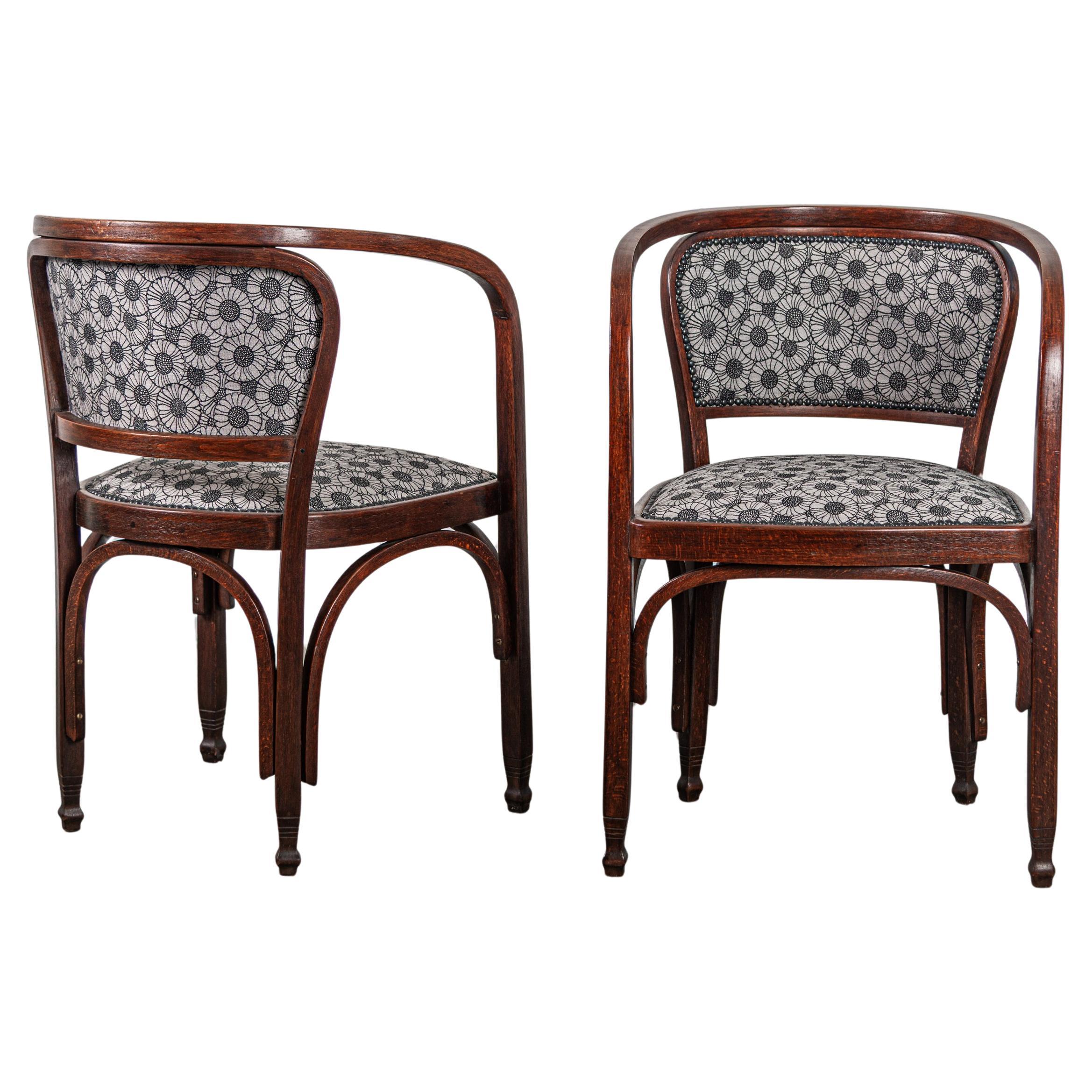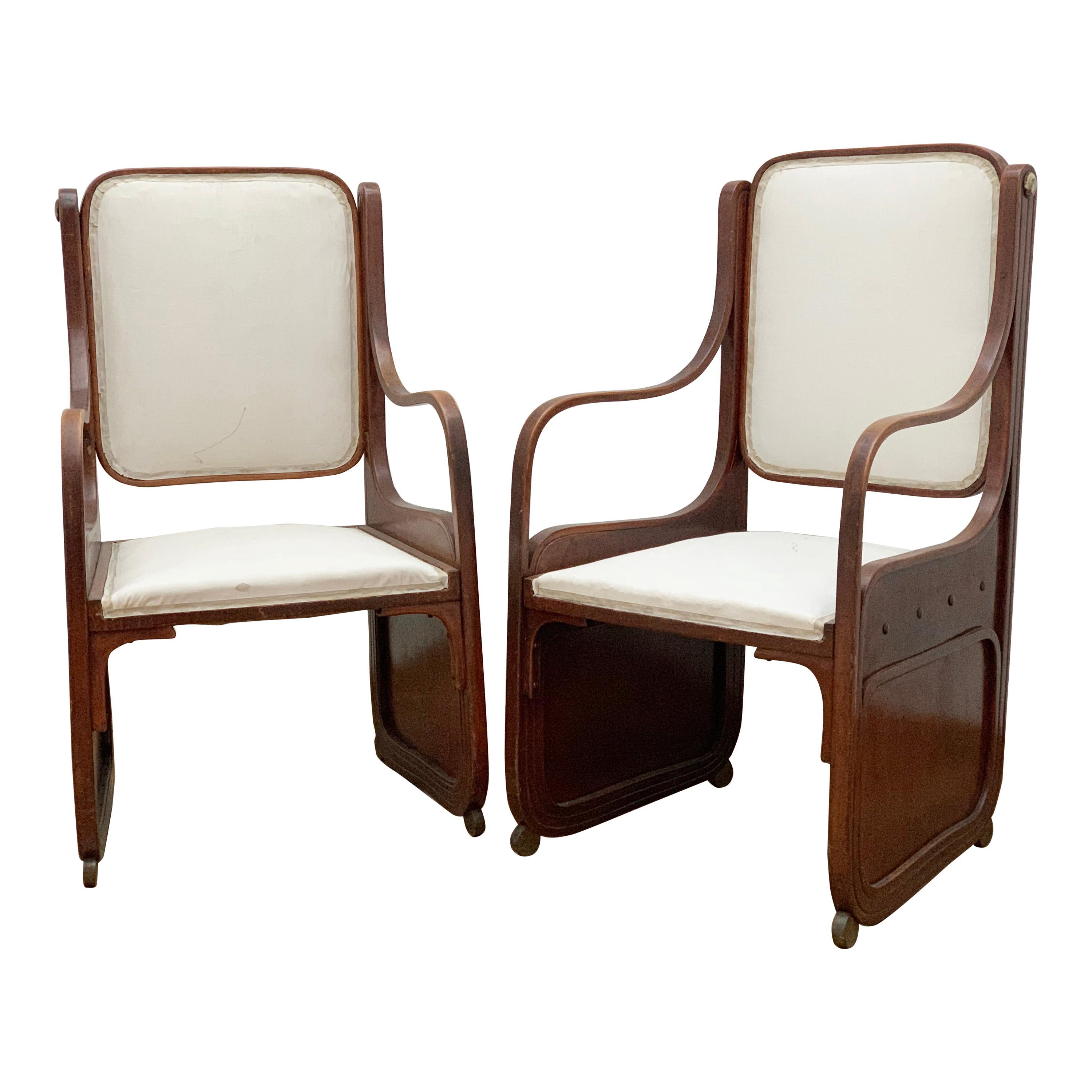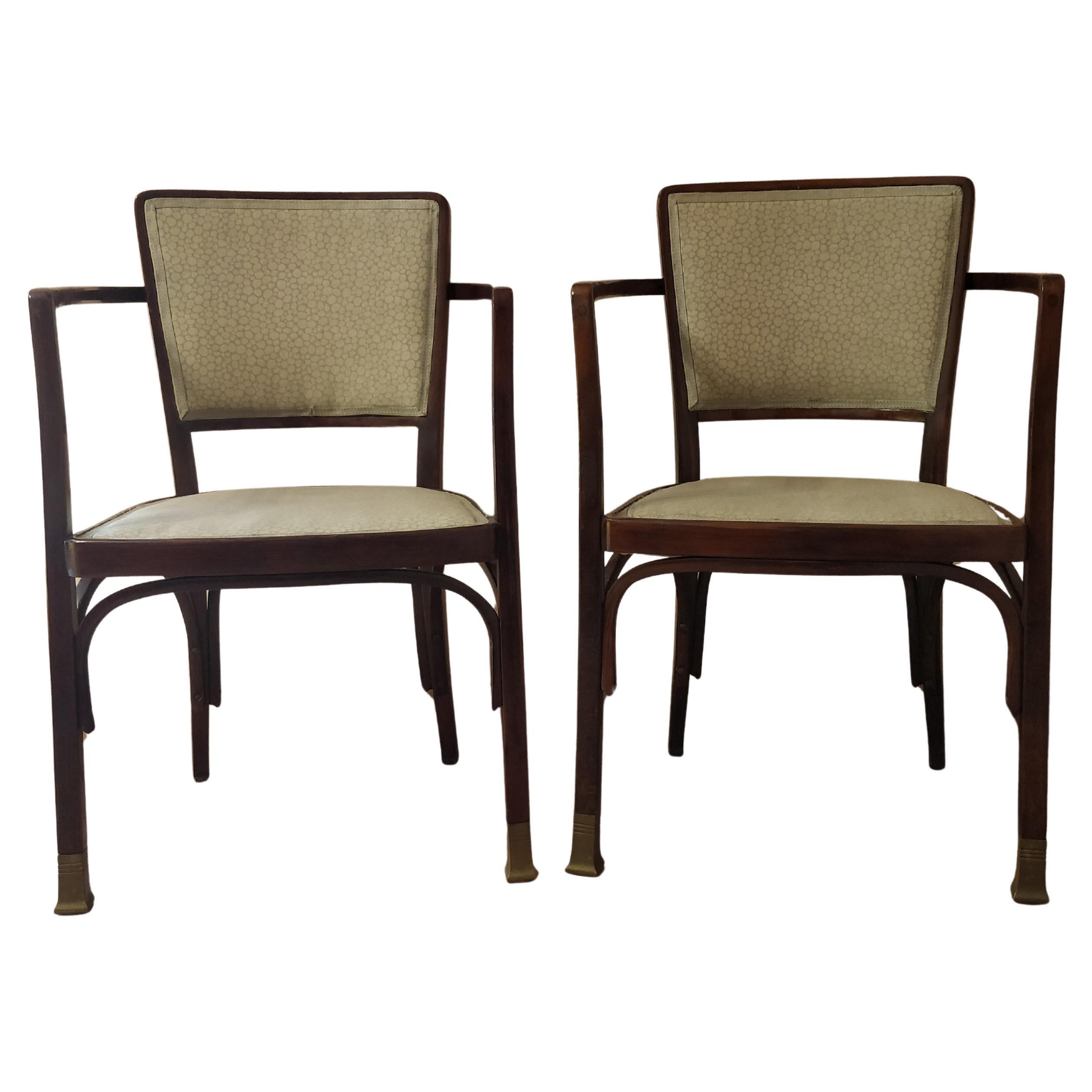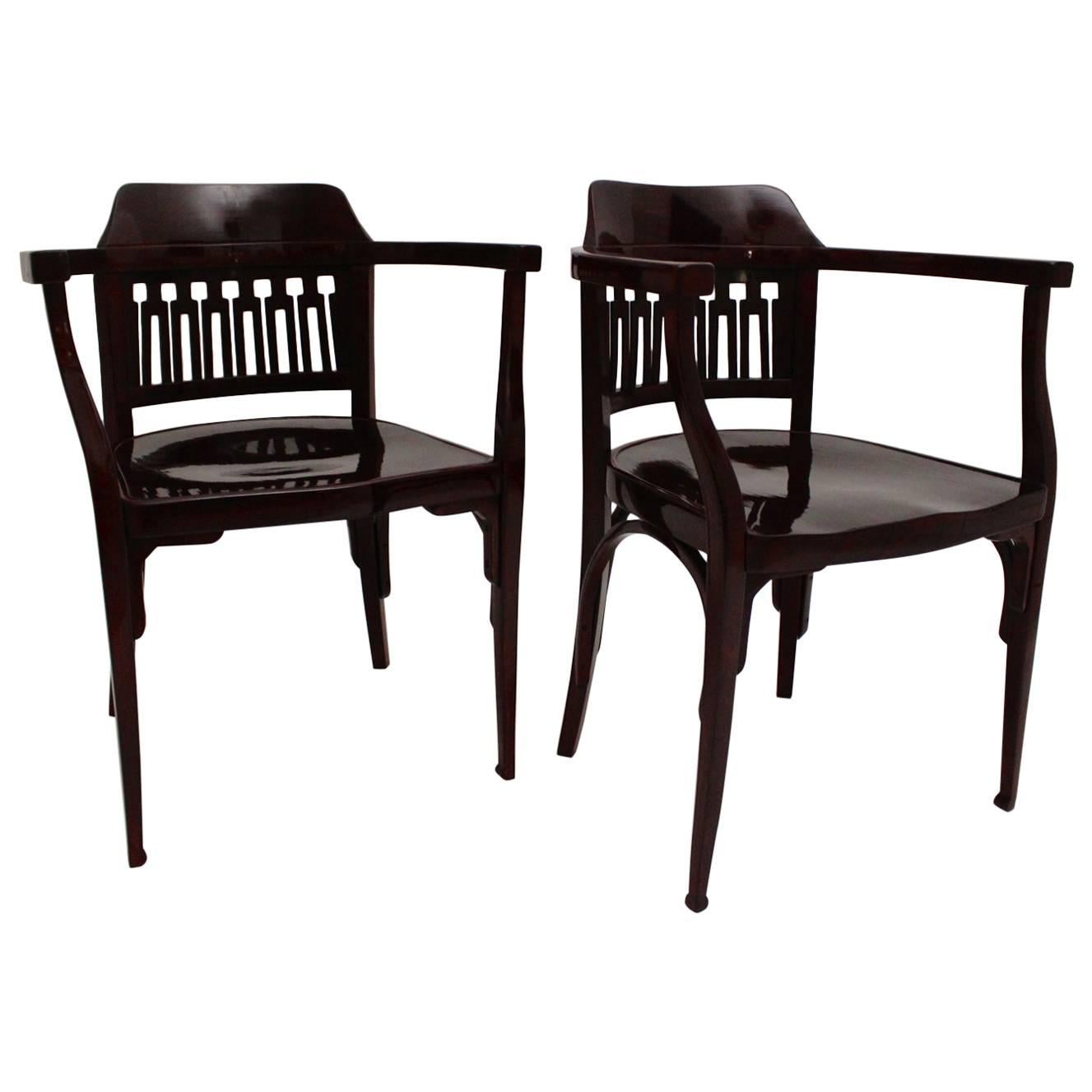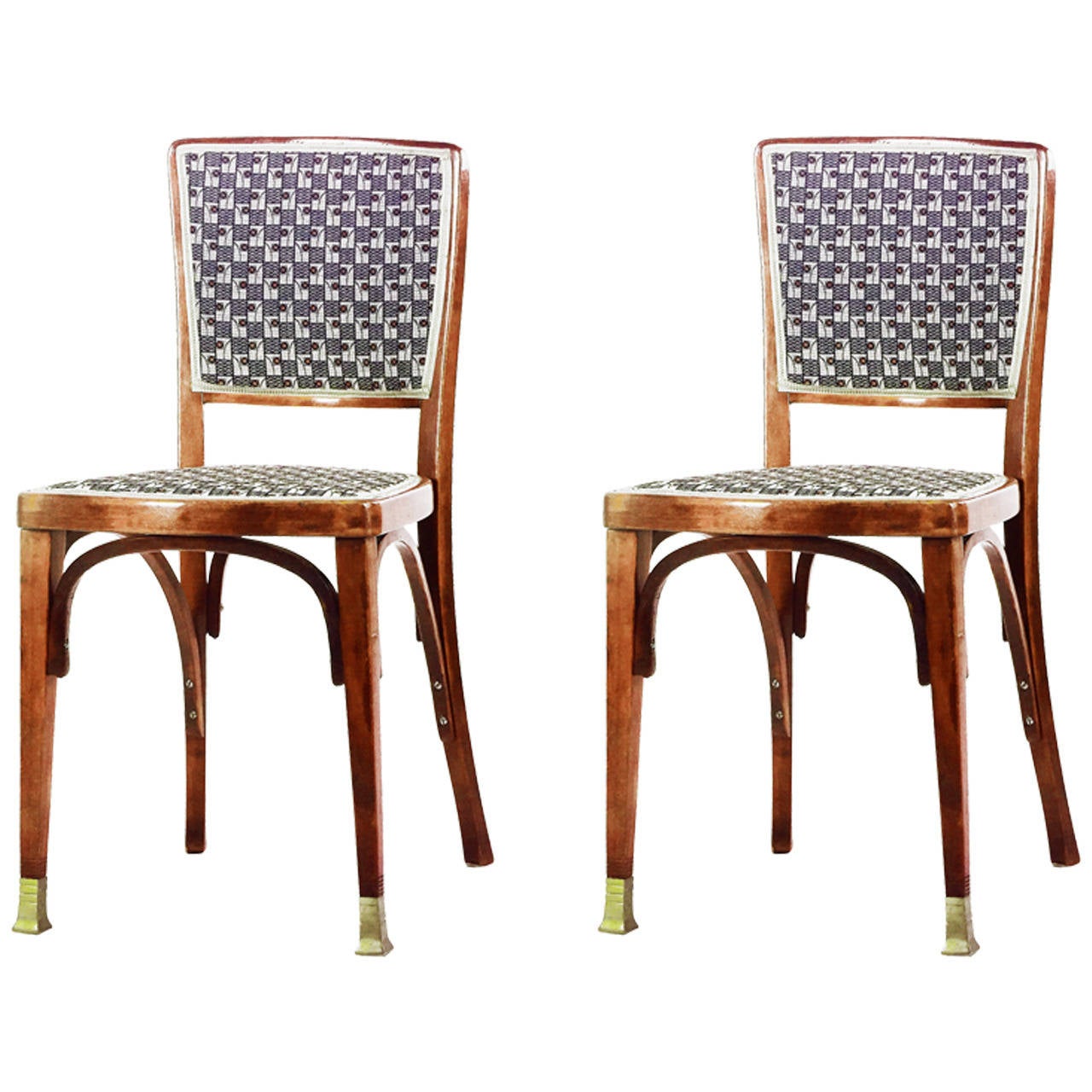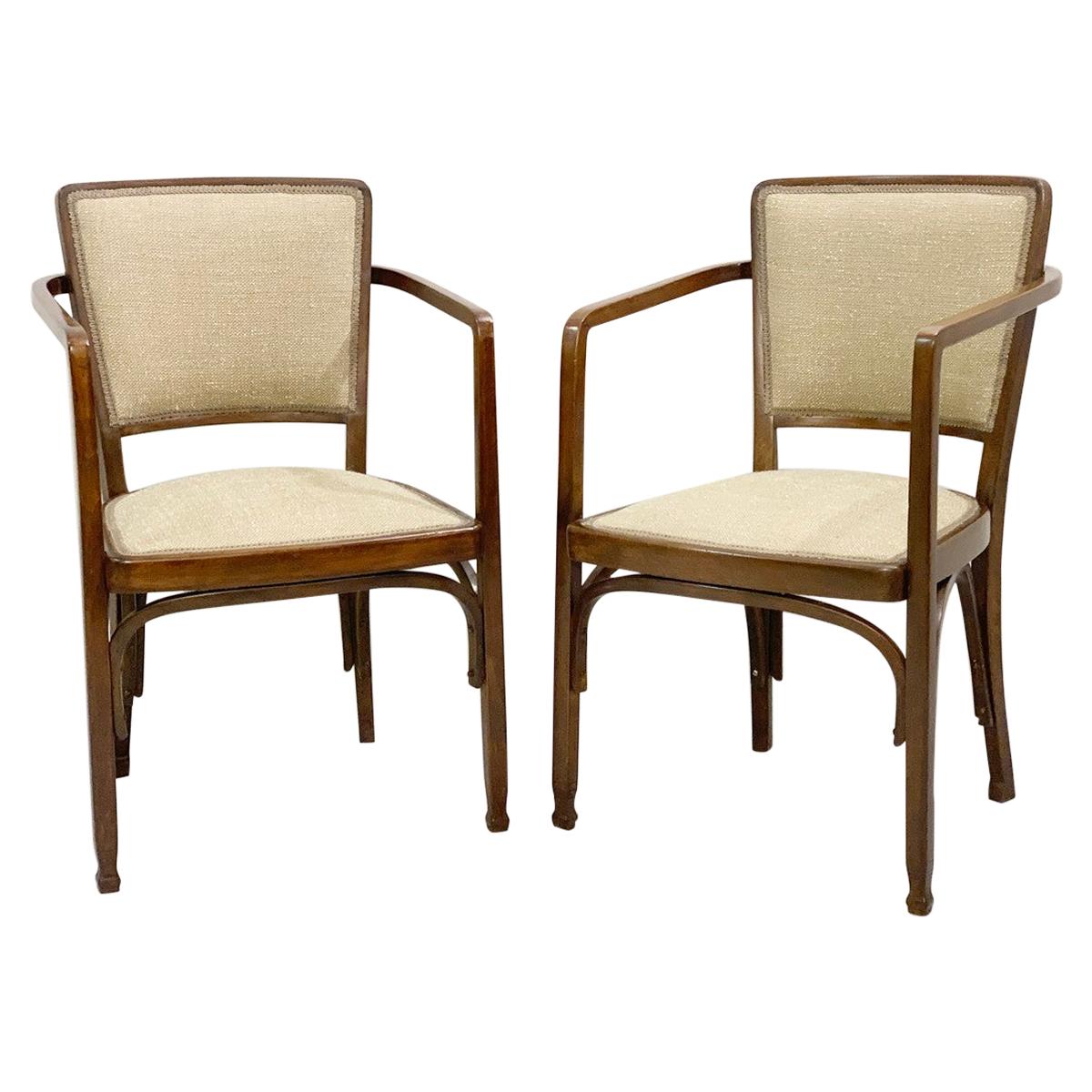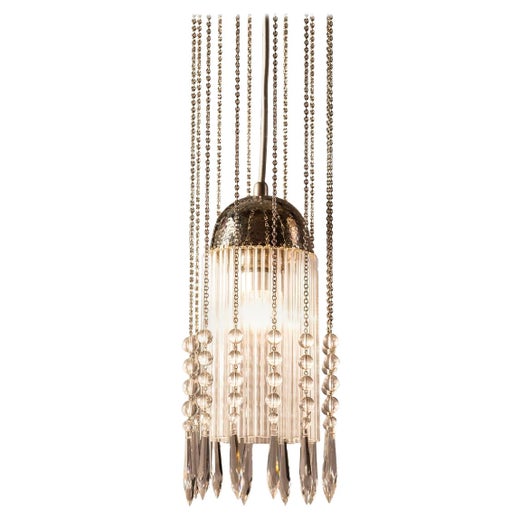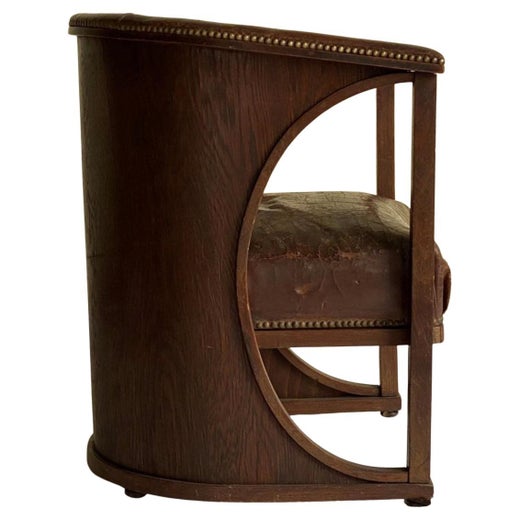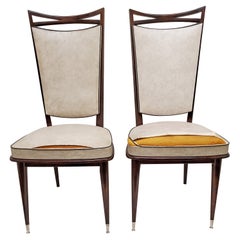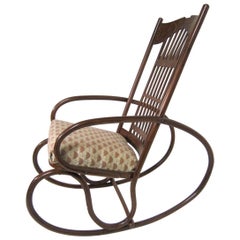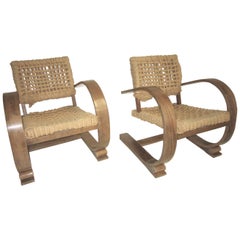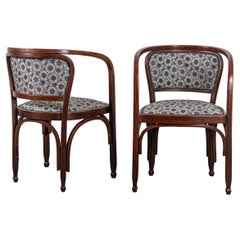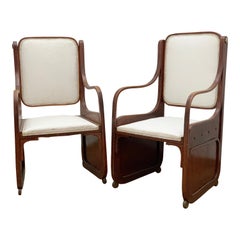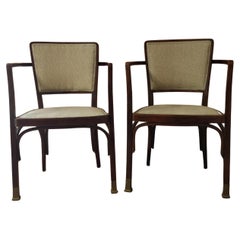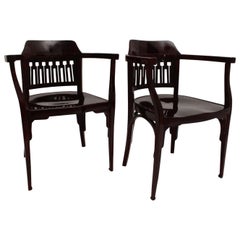Pair of Wiener Werkstatte armchairs by Koloman Moser for J & J Kohn, Austria
Informazioni sull’articolo
- Creatore:Koloman Moser (Designer),Jacob & Josef Kohn (Produttore)
- Dimensioni:Altezza: 87,63 cm (34,5 in)Larghezza: 52,07 cm (20,5 in)Profondità: 49,53 cm (19,5 in)Altezza della seduta: 45,72 cm (18 in)
- Venduto come:Set di 2
- Stile:Jugendstil (Del periodo)
- Materiali e tecniche:
- Luogo di origine:
- Periodo:
- Data di produzione:1900
- Condizioni:Rivestito. Rifinito. Usura compatibile con l’età e l’utilizzo. In good vintage condition w/ tiny imperfections, scuffs, marks. Refinished and reupholstered many years ago. Fabric in good condition, interior fill of cushions a bit flattened commensurate with age and use.
- Località del venditore:New York City, NY
- Numero di riferimento:1stDibs: LU901346862672
Koloman Moser
Nato a Vienna nel 1868, Koloman Moser frequentò brevemente una scuola di commercio, onorando il desiderio del padre di vederlo nel mondo del commercio. Ma presto si arrese alle sue inclinazioni artistiche, iscrivendosi nel 1885 all'Academy Arts di Vienna, dove studiò pittura.
Quando il padre morì inaspettatamente nel 1888, lasciando la famiglia in difficoltà economiche, Moser (1868-1918) diede una mano realizzando illustrazioni per libri e riviste. Nel frattempo, continuò a studiare pittura all'accademia e poi alla School of Arts and Crafts, a partire dal 1892. Quello fu anche l'anno in cui Moser, insieme ad altri giovani artisti in rivolta contro la devozione del mondo artistico viennese al naturalismo, formò il Siebner Club, il precursore della Secessione di Vienna.
L'introduzione di Moser durante l'ultimo trimestre di scuola a Gustav Klimt'Allegoria della Scultura si rivelò un punto di svolta per il giovane artista. Christian Witt-Dörring, curatore ospite della mostra 2018-19 "Koloman Moser: Artista universale tra Gustav Klimt e Josef Hoffmann" presso il MAK di Vienna, ha notato un cambiamento nello stile di disegno dell'artista. "Ispirandosi principalmente all'arte di del Giappone, [Klimt] introduce nuovi formati di carta, dettagli di immagine frammentati e un'enfasi sulla linea rispetto alla superficie", ha scritto Witt-Dörring nel catalogo della mostra.
Un anno dopo, nel 1897, Moser insieme a Carl Moll, Joseph Olbrich e Josef Hoffmann fondò la Secessione di Vienna, un'unione di artisti e designer decisi a rovesciare il conservatorismo artistico austriaco. I membri si impegnavano a realizzare opere d'arte totali: Gesamtkunstwerken. Guardando al Movimento Arts and Crafts inglese , con il suo principio guida dell'unità delle arti, il gruppo cercò di riportare l'arte nella vita quotidiana e di introdurre un modernismo locale nella Vienna di fine secolo. Moser, la cui appartenenza al club gli permise anche di entrare nella società viennese dell'alta borghesia, abbandonò la pittura a olio e proseguì con Gesamtkunstwerk.
Moser ha creato di tutto, dal design delle mostre all'ornamento della facciata dell'edificio della Secessione, fino al materiale grafico. Moser produsse anche manifesti e pubblicità nel suo "stile moderno" per varie aziende. Nel 1898 presentò i suoi primi pezzi d'arredamento, tra cui tappeti annodati a mano e copricuscini. Nel 1899, Moser iniziò quella che sarebbe diventata una cattedra a vita presso la School of Arts and Crafts. Il suo repertorio si è ampliato fino a comprendere mobili, ceramiche e motivi come il suo marchio di fabbrica a scacchiera. Si dedicò anche alla scenografia e alla moda e si affermò come designer di interni.
L'artista decorò la propria casa nel 1902, dopodiché ricevette una serie di importanti commissioni, in particolare la villa dell'industriale tessile Fritz Waerndorfer. Fu Waerndorfer a fornire il sostegno finanziario che permise a Moser e Hoffmann di fondare nel 1903 la Wiener Werkstätte, una piattaforma per realizzare pienamente il loro ideale di Gesamtkunstwerk. Due anni dopo, Moser sposò Edith Mautner von Markhof, figlia di uno dei grandi baroni industriali austriaci, e il suo lavoro prosperò.
Nel 1907, la Wiener Werkstätte si trovò in difficoltà finanziarie. Persa la fiducia nell'unità delle arti e disilluso dalla dipendenza del gruppo da ricchi mecenati come Waerndorfer, Moser lasciò la Werkstätte. An He tornò alla sua disciplina originaria, la pittura, che continuò a praticare fino alla sua morte prematura per cancro, nel 1918.
Oggi le opere di Koloman Moser, dai vasi di metallo ai gioielli, fino agli interni, sono ricercate e apprezzate. Scopri le creazioni radicalmente moderne di Moser su 1stDibs.
Jacob & Josef Kohn
Anche se il primo nome che viene in mente quando si pensa ai mobili in legno curvato potrebbe essere Thonet (creatore dell'iconica sedia Thonet No. 14 o "sedia da bistro"), Michael Thonet e il suo successivo studio, Gebrüder Thonet (Fratelli Thonet), avevano un forte concorrente nella Vienna del XIX secolo: Jacob and Josef Kohn (indicati anche come J. & J. Kohn).
Fondata nel 1849 da padre e figlio con il motto "Essere sempre un passo avanti", Jacob and Josef Kohn ha creato mobili moderni per interni ed esterni in faggio austriaco. All'inizio del XX secolo, dopo essersi affermata con la sua maestria nella produzione di qualsiasi cosa, dalle sedie agli appendiabiti e persino di mobili per bambole, J. & J. Kohn iniziò a lavorare a stretto contatto con la Wiener Werkstätte, la cooperativa di artigiani co-fondata dall'architetto e designer austriaco Josef Hoffmann (Gustav Klimt e Koloman Moser erano anche membri). Grazie a questa partnership, J. & J. Kohn produsse una serie di mobili in legno curvato, canna e tappezzeria, che vendette attraverso showroom in Europa e Nord America. I suoi design per tutto il primo decennio del XX secolo riflettono il movimento Art Nouveau che si stava rapidamente affermando in tutta Europa.
Durante la Prima Guerra Mondiale si scatenarono guerre di prezzo e fusioni. I cambiamenti nella struttura organizzativa di Thonet hanno incluso una fusione con l'azienda viennese Mundus all'inizio del XX secolo, che ha fatto seguito al fatto che Mundus è diventata azionista di maggioranza di J. & J. Kohn - queste fusioni hanno portato alla formazione di Mundus-Kohn e successivamente, nel 1922-23, Thonet-Mundus. Il nuovo conglomerato continuò a produrre esempi dei suoi mobili in legno curvato in linea con lo stile moderno della Secessione di Vienna. Mentre Thonet si è ricostruita, ha cambiato marchio e si è espansa negli Stati Uniti e altrove dopo la Seconda Guerra Mondiale, J. & J. Kohn non ha mai più prodotto mobili con quel nome.
Su 1stDibs trovi una varietà di mobili antichi di J. & J. Kohn, tra cui sedie wingback in legno curvato disegnate da Josef Hoffmann e altre sedute, tavolini, tavolini di faggio e altro ancora.
- SpedizioneRecupero del preventivo…Spedizione da: Queens, NY
- Politica di reso
Altro da questo venditore
Mostra tuttoMetà XX secolo, Francese, Mid-Century moderno, Sedie
Naugahyde, Faggio
Inizio XX secolo, Austriaco, Secessione di Vienna, Sedie a dondolo
Legno curvato
Metà XX secolo, Francese, Mid-Century moderno, Poltrone
Corda, Legno curvato
Metà XX secolo, Francese, Mid-Century moderno, Sedie per sala da pranzo
Naugahyde, Faggio
Metà XX secolo, Francese, Art Déco, Poltrone
Nickel
Metà XX secolo, Mid-Century moderno, Sedie per sala da pranzo
Naugahyde, Legno
Ti potrebbe interessare anche
Di antiquariato/d’epoca, Inizio Novecento, Austriaco, Jugendstil, Poltrone
Faggio
Di antiquariato/d’epoca, Inizio Novecento, Austriaco, Poltrone
Legno curvato
Di antiquariato/d’epoca, Early 1900s, Austrian, Poltrone
Ottone
Di antiquariato/d’epoca, Inizio Novecento, Austriaco, Jugendstil, Poltrone
Compensato, Faggio
Inizio XX secolo, Austriaco, Secessione di Vienna, Sedie senza braccioli
Ottone
Di antiquariato/d’epoca, Inizio Novecento, Austriaco, Poltrone
Legno
